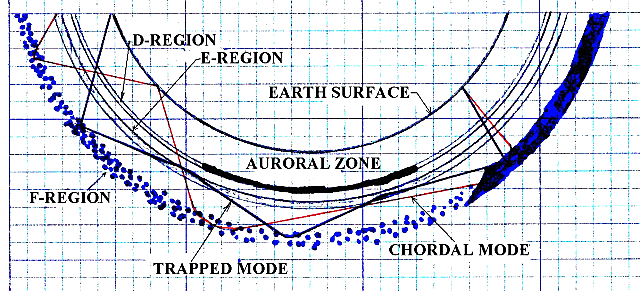
Longpath (LP) Experiment using ZL6B
By Gwyn Williams � G4FKH
When I started this exercise on the morning of 15th November 2006, I was looking for evidence of Sunrise/Sunset enhancements, commonly called greyline. I have actually been checking the HF bands for a number of years for evidence of this phenomenon without success. That is not to say that it does not happen on the lower bands. Just that the NCDXF beacon chain only covers 14MHz to 28MHz. Finding a suitable and reliable source of HF energy has proved difficult to say the least, that is why I use the NCDXF beacon chain with the monitoring program, FAROS.
When I started recording data with the above program, ZL6B was being received from about one hour following sunset at ZL for about 145 minutes each morning, these signals as confirmed by FAROS were LP. As ZL is almost at our antipode, I was extremely suspicious that the program was getting it wrong. FAROS measures the time taken for the signal to arrive to make this decision. The time difference for signals arriving via SP and LP is only 9 milliseconds. To eradicate any confusion I asked Derek G3RAU, who has a beam, to check the arrival path for me. He was able to confirm that signals were actually arriving via both paths but at the times that I was recording LP the signal strength via that method was higher. This concurs with FAROS, that software will choose the bigger signal when both paths are working.
Apart from operating (CW) my interest has always been propagation. Therefore I was intrigued as to which mode the signals were utilizing. From my QTH, LP to ZL is over the edge of N. Africa and the southern part of the Atlantic then clipping the Antarctic. I attempted to get ionosonde data from several stations in the Antarctic region but the only one that has been available is Casey, which is roughly 13 hours (daylight time) from my reflection point in the Antarctic. Stanley data is available but I considered this too far north of my reflection point for data extrapolation. One thing that the Casey data was able to show me and verified to some extent by the Stanley data was that blanketing sporadic-E was prevalent each day at my reflection point if I extrapolated the data forward. This would then cause the circumstances depicted in Fig. 1 to be observed at my reflection point/s.
Because as I�ve said there is lack of confirming data, there are two possible modes at the Antarctic that would account for my receiving enhanced signals here. Both are shown in Fig. 1, the first is a trapped mode, which traps a signal between the F-region and either the E-region or the sporadic-E region. The other mode, which I believe to be more likely, is the utilization of a Chordal hope mode at the Antarctic reflection point/s. Either of these circumstances would enable the signal strength at the receiver to be enhanced enough for reception.
This experiment lasted from 15/11/2006 to 07/03/2007 when LP disappeared. The duration of received signals showed a sinusoidal curve, as I would expect because the time difference of sunset in NZ and sunrise here grew apart, then got closer and grew apart again. The co-incidence of sporadic-E at the required place in the Antarctic follows the same pattern. Received signal strength remained pretty stable, at about 1 S-point during the reception periods.
I believe that keen DX-ers would know that LP is available with ZL at the above time of year but I wonder how many are aware of the exact mechanisms involved? My experiment showed that LP to ZL is available between (or before) November and March. To take better advantage, I use a multi-band dipole; a beam of some description is necessary. The signals would then be lifted up to about S-5 or S-6. The reception of ZL6B was on 14.100MHz; nothing was heard from this station on any of the higher bands during this period. Good luck and good DX-ing.
